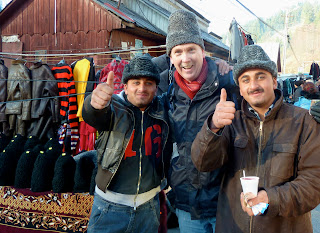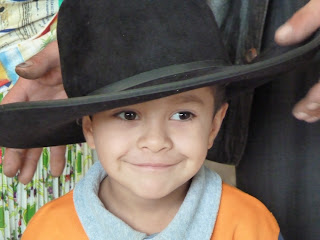Roma, Tigan, Gypsy, Gitanes: what’s in the name. Tigan, gitanes, gypsy comes from the greek word for “heathen,” “untouchable,” or “impure,” accused of heresy by the clergy in the middle ages. The term first appears in Byzantine writings in 1068, noting that they were astrologers and wizards to be avoided. In Romanian writings, the term designated the social status of a slave, or outside society, not considered human. The term continues to carry negative meanings in Romanian mentality. The Roma themselves refer to themselves by their clan or caste, Gabori, Caldera, or other designations.

Romanians have an extremely negative view of Roma, as many of them are beggars, thieves, or scavengers in the garbage dumps. And Roma have an equally negative view of the negative elements of their race, as Ghizi said, "they ruin our reputation; we are honest and hard-working, and they give us a bad name."
Their trade is passed on from parent to child, so if a parent is a member of the Tshor (thief clan), the children learn to pickpocket and steal at an early age. In our orientation, an embassy staff member related walking to the gym in the early morning greeted by several cute gypsy children; when he got to the gym he discovered that every outside zipper pocket on his gym bag was opened and emptied.
Roma history is unclear, because the earliest accounts of Roma were written by outsiders with a negative point of view. The best guess is that the Roma migrated to Eastern Europe from the Indian continent in two waves: the first wave was in 1200s as slaves to the invading Tartars; when the Tartars were defeated, they became slaves to the locals. The second wave was in the 1500s, an economic migration into a feudal society where they were nomads. They were granted freedom from slavery in 1837 by the Council of Wallachia, which also gave them farmland.
During WWI and WWII, the Roma began to develop an identity as a separate cultural group. However, during WWII the Nazi regime saw the Roma's separatist and nomadic ways as a cultural problem necessitating genocide as a solution. The Communist regime which followed attempted to assimilate Roma into Romanian society, offering them jobs in factories and agriculture. But the state policy of "social uniformity" went against their core values, so they withdrew to remote villages and traditional trades in a black market economy. After the fall of Communism, many Roma who assimilated into urban factory work lost their jobs as factories closed. Those who resisted assimiliation in rural areas seemed to adapt to free enterprise much better.
Theirs is a collective society, so one member’s success is meant to be shared with the family or clan. So, many gypsies make a good living, but spend all they make on their friends and family. The musician caste is notorious, even among the Roma, for spending all they make on food and drink for their friends. They are the original "grasshopper and the ant" fairy tale, living only for today's enjoyment.
Their occupation is based on hereditary factors, the son does the same trade as the father, and families who practice the same trade affiliate together as clans. Their identity is based in the trade, even if modern culture has made the trade obsolete. A clan consists of 30-40 families in the same area, and, in addition to practicing the same trade, they speak the same dialect of Roma language and have the same economic status. The Roma are extremely sensitive to what one’s class and status is and do not mix with Roma of other class.
When we went to the party with the musicians, our host Gabi, a Gabori by trade, was aloof from the other Roma, musicians by clan and class. Although everyone had brought their best homemade liqueurs, he declined having any alcohol, saying that he was the designated driver for our group. When everyone else was dancing, he had a smoke outside the fence.
 |
| Gabi's Grandfather made the water well dome. | |
|
The clans include:
o Tinkers
o Musicians: keepers of gypsy folklore and tradition
o Bear tamers, entertainers who worked in circuses and traveling shows.
o Carpet sellers
o Caldararii: "the tent dwellers," formerly nomadic gypsies who make things from copper and brass, such as cauldrons, jewelry, or roof tiles.
o Blacksmiths: after blacksmithing ceased to be used, these went into industry and took advantage of higher education. These were the first to lose their language and identity as Roma; other clans point to them as examples of the bad consequences of too much education.
o Horse breeders, or "gypsy with a horse," farm workers and menial laborers
o Silversmiths
o Woodworkers: make wooden dishes and spoons.
o Vatrashii: traditional artisans who are sedentary (non-nomadic)
o Gaborii: tinsmiths,metalworkers who make drains and gutters.
o Cocalarii: ivory carvers who make combs or hair accessories (feathers or jewelry)
A USAID document on the Roma in Romania lists several common characteristics of Roma communities:
1. The memory of nomadic life persists in a strong sense of separation from the dominant culture. Often Roma live in small houses with few amenities. Even wealthy Roma who may build “Gypsy palaces” live in modest one-room homes near the large, impressive, and empty house. The Gabori family lived in one large room with table and chairs and couch-beds that would seat 16-20 and sleep the entire family, even though they had four other bedrooms.
2. A second residue of nomadic life is a general disregard for government. Marriages are a big deal in Roma culture, but frequently they fail to register them with the civil authorities. Income is usually cash-based, and income taxes are regularly evaded.

3. The importance of the family and clan. Children are cared for by Roma families, not given for adoption or orphanages, and elderly are cared for by their families. The most important event in Roma culture is the birth of the first son. Even if there are several girls in the family, the first son has a special place in the family value. Usually, the youngest boy has the duty of caring for the parents, although all male children are expected to live nearby and contribute to the family trade and income. Girls, on the other hand, are expected to become part of their husband’s family, and can only care for her parents if the husband’s family consents.
4. Another characteristic is disregard for education, although they hold teachers and professors in high regard. A Roma proverb, “time teaches more than books,” captures their disregard for formal education. Too much education risks disrupting the strict roles expected of boys and girls. As our host, Ghizelle, related in a matter-of-fact way, her older daughter’s husband didn’t want her to read books because she would get foreign ideas and not be satisfied with Roma culture. On the other hand, Ghizelle was proud of her second daughter, Gabrielle, who could read above her grade level; nevertheless, Ghizelle saw Gabrielle’s future only as marrying and moving to another household.


























